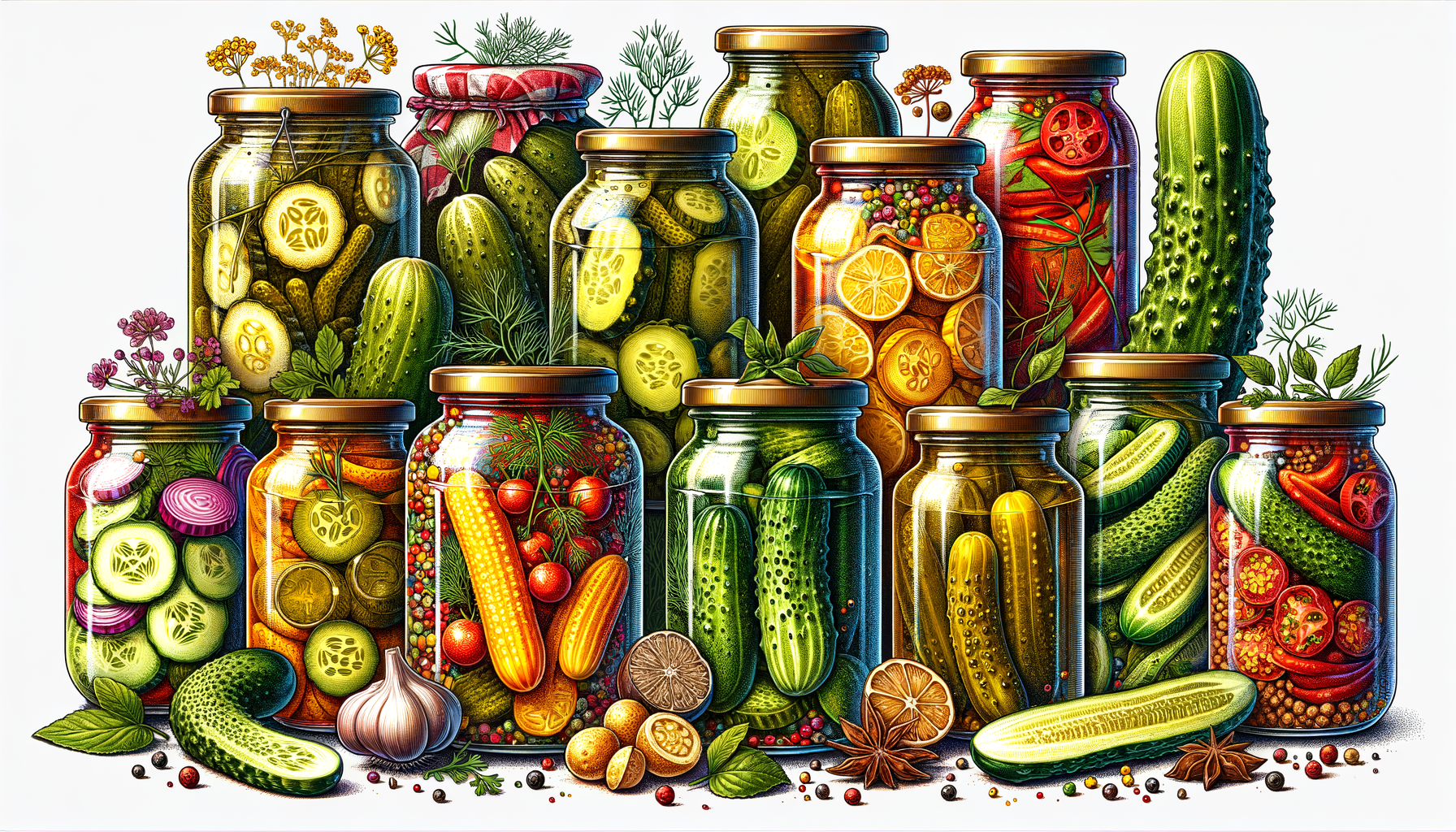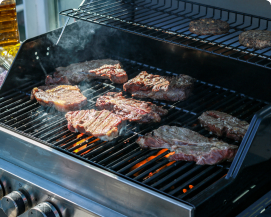Pickles have been a part of human cuisine for thousands of years. The process of pickling was developed as a way to preserve food for out-of-season use and for long journeys, especially by sea. The tangy treats we enjoy today owe much to this practical beginning, but pickles are more than just a culinary footnote; they are a diverse and versatile part of many cultural cuisines and have benefits that may surprise you.
The Pickling Process and Varieties
Pickling is essentially the process of extending the lifespan of food by either anaerobic fermentation in a brine or immersion in vinegar. The high-acidity environment prevents the growth of bacteria that would typically cause food to spoil. The result is a preserved product with a vastly different taste and texture.
The most common pickled item across the globe is the pickle or gherkin, which is made from cucumbers. However, many different vegetables and fruits can be pickled, including onions, carrots, cauliflower, radishes, and even watermelon rinds. Each region has its own favorites and methods. For example, kimchi—a staple in Korean cuisine—is made with fermented vegetables like cabbage and radishes, seasoned with a variety of spices, including chili pepper and garlic. In contrast, dill pickles, which are popular in North America, are made by fermenting cucumbers in a brine solution with dill weed and seeds.
Natural Fermentation vs. Vinegar Pickling
There are two primary methods of pickling: natural fermentation and vinegar pickling. Natural fermentation involves submerging the produce in a brine solution and allowing the natural process of lactic acid fermentation to occur, giving the pickles a distinctive sour flavor. In vinegar pickling, produce is submerged in a mixture typically made of water, vinegar, and salt, sometimes with the addition of various herbs and spices. Unlike naturally fermented pickles, vinegar pickles don’t usually undergo fermentation. Many store-bought pickles are vinegar-based, as this method offers a more consistent and controllable flavor and a faster production process.
Cultural Significance of Pickles
The cultural importance of pickles spans around the globe and is deeply entrenched in regional customs and traditions. In India, pickles, known as “achar”, are fiery blends of vegetables and fruits, many times including mangoes, limes, and chilies along with aromatic spices like fenugreek, mustard and asafetida. These are not just accompaniments to Indian meals but also considered beneficial to the digestion.
In Japan, “tsukemono” refers to a wide array of pickled delicacies, which are an essential part of the Japanese diet. They often include umeboshi, which are sour pickled plums, and are valued for their purported health benefits, including promoting digestion and vitality.
European pickling tradition is extensive, too. Many eastern European countries like Poland and Russia prize pickles for their robustness in staying preserved through harsh winters. Think of Polish gherkins or Russian “solénie” which include a diverse assortment of pickled cucumbers, tomatoes, and cabbage.
Health Benefits of Pickled Foods
While pickled foods are appreciated for their taste and versatility, they also possess numerous health benefits. Here are a few to consider:
Gut Health
Naturally fermented pickles are a source of probiotics, the ‘good’ bacteria that can help maintain a healthy balance in your gut microbiome. These probiotics are common in foods like yogurt and kefir and are also abundant in foods like sauerkraut and kimchi. Regular consumption of these can help support digestive health and the immune system.
Vitamins and Minerals
Pickling can preserve or even boost the nutrient content of foods. Many pickles contain a mixture of vitamins like vitamin K and vitamin A, and minerals such as iron, calcium, and potassium. However, the exact nutritional content varies widely based on the type of produce being pickled and the method used.
Antioxidant Properties
Many fruits and vegetables have natural antioxidants that are preserved through the pickling process. These antioxidants fight off free radicals, which are harmful molecules that can damage cells and contribute to aging and diseases like cancer.
How Pickles are Enjoyed Around the World
Pickles are eaten in numerous ways worldwide, from a side dish or condiment to being the star of the plate. They can be chopped and added to salads, or placed alongside meats and cheeses on a charcuterie board. Some cultures will eat pickles on their own as a snack. Additionally, pickle juice is also being consumed for its purported health benefits and is even sometimes used as a workout recovery drink because of its electrolytes.
Homemade vs. Store-Bought Pickles
While store-bought pickles are convenient, homemade pickles offer a level of customization and freshness that is hard to beat. You can control the ingredients you use, adjust the levels of salt or sugar, and experiment with different herbs and spices. Making pickles at home is also a rewarding way to preserve seasonal produce and reduce food waste.
Basics of Making Your Own Pickles
Making your own pickles can be incredibly simple. Basic ingredients usually include your main item to pickle (cucumbers, carrots, onions, etc.), distilled white vinegar or apple cider vinegar, water, salt (preferably pickling or kosher salt without iodine), sugar (optional, depending on the recipe), and any combination of spices (such as dill, mustard seeds, garlic, or peppercorns).
The general process involves cleaning and cutting your produce, preparing the brine or vinegar mix, and then combining the two in jars to be stored. There is a range of methods, from quick pickling—which can be eaten within hours—to fermenting, which can take several days or weeks.
Fun Facts about Pickles
– In the United States, National Pickle Day is celebrated on November 14th.
– Pickle-flavored products have become more popular in recent years, including pickle-flavored chips, popcorn, and even ice cream.
– According to some historical accounts, Julius Caesar and Napoleon were among the many leaders who valued pickles for their health benefits, providing them to their troops to boost strength and vitality.
– The term “in a pickle” was first introduced by Shakespeare in his play The Tempest, reflecting a dire or difficult situation—quite unrelated to the actual pickled vegetables.
Finishing Thoughts
Pickles are a fascinating and flavorful part of human culture. They span vast geographical and cultural boundaries, preserving not only food but also tradition and history. Whether you’re enjoying a tangy dill pickle as a snack or a serving of spicy Indian achar with your meal, you’re participating in an age-old practice that has nourished and intrigued humanity for generations.
Beyond their wonderful taste, pickles offer numerous health benefits and can be enjoyed in a variety of ways. Making pickles at home can be a rewarding and creative endeavor, allowing you to partake in a culinary process that is as old as civilization itself. So the next time you take a bite of a crisp, tart pickle, remember that you are savoring a piece of a much larger world of tangy treats—a world rich with history, culture, and a tapestry of flavors.“`html
Frequently Asked Questions
What are the health benefits of eating pickles?
Pickles are known for their probiotics, which are beneficial bacteria that can aid in digestion and promote a healthy gut. They are also low in calories and a good source of vitamins, such as vitamin K. However, they can be high in sodium, so it’s important to consume them in moderation.
How are pickles made?
Pickles are made through the process of fermentation where cucumbers are soaked in a solution of water and salt. This creates an environment where beneficial bacteria can thrive and leads to the sour taste pickles are known for. Some pickles are made using vinegar instead of fermentation, which also gives them their tangy flavor.
Can you make pickles at home?
Yes, making pickles at home is quite simple. All you need are cucumbers, salt, water, and your choice of spices. For quick pickles, you can also use vinegar. The key is to ensure everything is clean and sterilized to avoid any unwanted bacterial growth.
Are there different types of pickles?
There are many types of pickles, including dill pickles, sweet pickles, bread and butter pickles, and gherkins. There are also pickles made from other vegetables and fruits, like kimchi (Korean pickled cabbage), sauerkraut (fermented cabbage), and pickled onions.
What can you serve pickles with?
Pickles can be served with a wide range of dishes. They are often paired with sandwiches, burgers, hot dogs, and salads. They also make a great addition to charcuterie boards, or as a tangy accompaniment to rich and creamy dishes to balance the flavors.
Do pickles have a long shelf life?
Yes, due to the high acidity of pickles they can have a long shelf life when stored properly. Unopened pickles can last for up to two years when stored in a cool, dark place. Once opened, they should be kept in the refrigerator and will typically last for several months.
What’s the difference between pickling and fermenting?
Pickling involves preserving foods in an acidic solution, often vinegar, and can include the addition of spices for flavor. Fermenting, on the other hand, is the process where natural bacteria feed on the sugar and starch in the food, producing lactic acid. This process creates the environment that naturally preserves the food and develops complex flavors.
Can pickling preserve any type of vegetable?
Most vegetables can be pickled, though the results can vary depending on the vegetable’s water content, texture, and flavor. Commonly pickled vegetables include cucumbers, carrots, cauliflower, peppers, and beets. However, softer vegetables might not retain their texture as well.
Are pickles suitable for a vegetarian or vegan diet?
Generally, pickles are suitable for both vegetarian and vegan diets as they do not contain animal products. However, it is always recommended to read the label as some brands may use additives or processing methods that are not vegetarian or vegan.
“`













